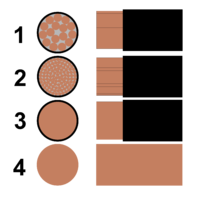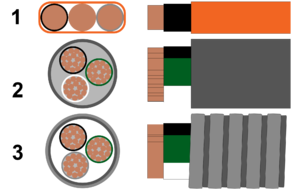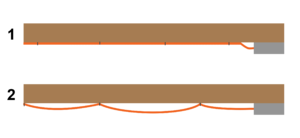Conductor types
The term conductor is used to refer to both wire and cable. Conductors allow the safe transport of electricity between all of the different components of an electrical system. Wire refers to a single conductor whereas cable contains various wires within an additional layer of insulation protecting them. The conducting material of a wire may be copper or aluminum and its size varies based the amount of current that it will be required to carry, the voltage and the conditions. For off-grid PV systems copper is typically used as it can carry more current for the same size conductor and is easier to bend and manipulate. Conductor insulation made of plastics or rubber and varies in color depending upon the application and location. It will also vary in thickness depending upon the voltage rating of the conductor as a higher voltage rating will require additional insulation.
The conductors for an off-grid system must will be sized and selected based upon the load evaluation and the physical evaluation for a particular site. This process must be done in conjunction with the sizing and selection of an overcurrent protection device for the circuit - see Wire, overcurrent protection, and disconnect sizing and selection for more information.
Contents
Conductor types
Besides their maximum current rating, conductors have additional other classifications.[1]
Stranding
- Stranded - standard stranded cable is the most commonly used type of conductor as it is easy to work with under most circumstances and is relatively cheap.
- Fine stranded - fine stranded cable is preferrable when working with batteries or in tight spaces as it is easier to bend and manipulate.
- Solid - typically only used for indoor wiring. Slightly cheaper than stranded conductor, but most difficult to bend and manipulate. Should not be used any larger than 10 AWG / 4 mm².
- Bare (no insulation) - a cheap and durable option that can be used as part of a grounding system outdoors without a conduit if in a location where it will not be damaged.
Insulation and conditions of use
These classifications should be printed on the side of any conductor, although the exact terminology may vary based upon location. Below are some of the designations that are commonly used for wires used in off-grid PV systems.
| Classification | Common designation |
|---|---|
| Maximum insulation voltage | 600 V, 1000 V, 2000 V |
| Heat resistance | 60°C, 75°C, 90°C |
| Durable thermoplastic insulation | T |
| Synthetic polymer, flame-resistant | X |
| R | Rubber or Neoprene insulation |
| Heat resistant up to 75°C | H |
| Heat resistant up to 90°C | HH |
| Rated for use in wet locations | W |
| Nylon-coated to resist damage from oil or gasoline | N |
| Low emission of smoke and hazardous gases during a fire. | LS |
Common conductor types used with off-grid PV systems
There are countless different types of conductor, but there are only a few types that are commonly used with off-grid PV systems:
| Designation | Characteristics | Use |
|---|---|---|
| THHN/THWN | Rated for up to 90°C in wet or dry locations. 600V rating. Available in nearly any size. | Used for circuits of any kind - inside or outside - within a conduit. |
| RHH RHW, or XHHW-2 | Flexible insulation rated. Characteristics may vary. | Battery wiring. |
| PV wire/USE-2/RHW-2 | Rated for up to 90° in wet or dry locations. Can be exposed to sunlight. Voltage rating 600-2000 V. Typically only found in certain sizes (12 AWG, 4 mm², 10 AWG, 6 mm²) | Wiring of PV source and from PV source to combiner box or charge controller. |
Cable types
All circuits involve more than one conductor, therefore using cables that include multiple cables can save time and reduce costs on installations. Additionally, using cables of this type brings advantages that single wires do not offer.
| Type | Characteristics | Use |
|---|---|---|
| Non-metallic indoor rated (NMC) | A varying number of wires of a chosen size bundled inside of a flexible plastic jacket or fused together. Cheap and easy to use with but should only be installed in locations where it is protected from damage or in a conduit if it is an appropriate type of cable to be used in a conduit. | Indoor circuits in protected locations. |
| Service entrance cable (SE and USE) | A varying number of wires of a chosen size bundled inside of multiple layers of insulation that provide excellent protection against damage, water and degradation. SE cables can only be used above ground and have a a jacket that provides protection against sun damage and fire. USE cables can be directly buried underground without conduit if at a sufficient depth, but do not have the same protection against the sun or fire. Cheap and easy to use. | Outdoor circuits that need to be run underground. |
| Metal clad indoor rated (MC) | A varying number of wires of a chosen size bundled inside of a flexible metal jacket. More expensive than other cable options but provides superior protection. | Indoor wiring used in a location where it must be protected. |
| Stranded parallel thermoplastic (STP) | Two conductors joined together by plastic that are used to for one circuit. Cheap and easy to use with. Should be installed in a conduit. | Low-current indoor circuits. |
Securing and supporting wires and cable
Wire and cable do not always have to be run in conduit if they are not in a location where they will be exposed to damage, like an attic or under a PV module. If they are not placed in conduit, they still must be properly secured and supported appropriately. The electrical code for the location will specify the minimum distance between supports, although the appropriate distance between supports should ultimately be determined based upon what will offer the most protection from accidental contact or damage from friction. Cables and wires should be snug against the surface they are being run against rather than drooping or dangling, although they should not be so tight that they are being significantly strained between supports. It is important to offer additional support near junction boxes as strain placed near a connection can lead to its failure.
Projected life
If conductors are installed under proper conditions and not damaged, they should last for decades. Sunlight, abrasion, or excessive movement will gradually destroy any type of conductor.
Maintenance
All wiring should be checked at least once a year to make sure that it is not deteriorating or on the verge of failure.
Recyclability
Conductors contain copper or aluminum, both of which are valuable metals. Conductors can be recycled in major cities in nearly any part of the world at many different scrap facilities.
Notes/references
- ↑ Multi/Cable wire abbreviations and descriptions https://www.multicable.com/resources/reference-data/wire-abbreviations-and-descriptions/


